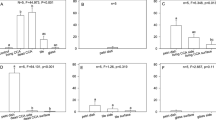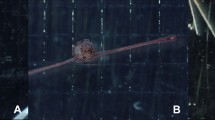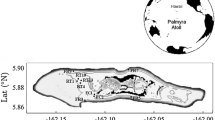Abstract
To test whether coral planulae recruit randomly to different coral reef habitats or have specific substratum preferences, the settling behavior of planulae from two shallow water coral species from Pago Bay, Guam (13°25.02N, 144°47.30E) were examined in the laboratory in June and July of 1995. Goniastrea retiformis is generally restricted to the shallow reef front (<10 m depth) in areas dominated by crustose coralline algae (CCA), while Stylaraea punctata is abundant on inner reef flats were CCA coverage is low and sand and carbonate rubble covered by biofilms is common. When presented with four substrata (1) carbonate rock scrubbed free of biofilm and dried as a control, (2) the CCA Hydrolithon reinboldii, (3) the CCA Peyssonelia sp., and (4) naturally conditioned carbonate rubble covered by a biofilm, G. retiformis larvae showed a significant preference for H. reinboldii, and S. punctata larvae for the carbonate biofilm treatment. The preference shown by S. punctata larvae for biofilmed surfaces did not diminish with increasing larval age up to 11 days. These results suggest that the larvae of both species are capable of habitat selection, and that the preferred substrata among those tested bears a relationship to the habitats in which adult colonies were found.



Similar content being viewed by others
References
Babcock R, Mundy C (1996) Coral recruitment: consequences of settlement choice for early growth and survivorship in two scleractinians. J Exp Mar Biol Ecol 206:179–201
Baird AH, Hughes TP (2000) Competitive dominance by tabular corals: an experimental analysis of recruitment and survival of understorey assemblages. J Exp Mar Biol Ecol 251:117–132
Baird AH, Morse ANC (2004) Induction of metamorphosis in larvae of the brooding corals Acropora palifera and Stylophora pistillata. Mar Freshw Res 55:469–472
Baird AH, Babcock RC, Mundy CP (2003) Habitat selection by larvae influences the depth distribution of six common coral species. Mar Ecol Prog Ser 252:289–293
Carlon DB (2002) Production and supply of larvae as determinants of zonation in a brooding tropical coral. J Exp Mar Biol Ecol 268:33–46
Coon SL, Fitt WK, Bonar DB (1990) Competence and delay of metamorphosis in the Pacific oyster Crassostrea gigas. Mar Biol 106:379–387
Goreau NI, Goreau TJ, Hayes AL (1981) Settling, survivorship and spatial aggregation in planulae and juveniles of the coral Porites porites (Pallas). Bull Mar Sci 31:424–435
Hadfield MG, Paul VJ (2001) Natural chemical cues for settlement and metamorphosis of marine invertebrate larvae. In: McClintock JB, Baker BJ (eds) Marine chemical ecology. CRC Press, Boca Raton, pp 431–462
Harrigan JS (1972) The planulae larvae of Pocillopora damicornis, lunar periodicity of swarming and substratum selection behavior. Ph.D. thesis, University of Hawaii, Hawaii, p 319
Harrington L, Fabricius K, De’ath G, Negri A (2004) Recognition and selection of settlement substrata determine post-settlement survival in corals. Ecology 85:3428–3437
Heyward AJ, Negri AP (1999) Natural inducers for coral larval metamorphosis. Coral Reefs 18:273–279
Highsmith RC (1982) Induced settlement and metamorphosis of sand dollar (Dendraster excentricus) larvae in predator-free sites: adult sand dollar beds. Ecology 63:329–337
Lewis JB (1974) The settlement behavior of planulae larvae of the hermatypic coral Favia fragum (Esper). J Exp Mar Biol Ecol 15:165–172
Morse DE (1990) Recent progress in larval settlement and metamorphosis: closing the gaps between molecular biology and ecology. Bull Mar Sci 46:465–483
Morse DE, Morse ANC (1991) Enzymatic characterization of the morphogen recognized by Agaricia humilis (scleractinian coral) larvae. Biol Bull 181:104–122
Morse DE, Hooker N, Morse ANC, Jensen RA (1988) Control of larval metamorphosis and recruitment in sympatric agariciid corals. J Exp Mar Biol Ecol 116:193–217
Morse ANC, Iwao K, Baba M, Shimoike K, Hayashibara T, Omori M (1996) An ancient chemosensory mechanism brings new life to coral reefs. Biol Bull 191:149–154
Mundy C, Babcock R (2000) Are vertical distribution patterns of scleractinian corals maintained by pre- or post-settlement processes? A case study of three contrasting species. Mar Ecol Prog Ser 198:109–119
Negri AP, Webster NS, Hill RT, Heyward AJ (2001) Metamorphosis of broadcast spawning corals in response to bacteria isolated from crustose algae. Mar Ecol Prog Ser 223:121–131
Pawlik JR, Hadfield MG (1990) A symposium on chemical factors that influence the settlement and metamorphosis of marine invertebrate larvae: introduction and perspective. Bull Mar Sci 46:450–454
Raimondi PT, Morse ANC (2000) The consequences of complex larval behavior in a coral. Ecology 81:3193–3211
Richmond RH (1985) Reversible metamorphosis in coral planulae larvae. Mar Ecol Prog Ser 22:181–185
Richmond RH (1987) Energetics, competency, and long-distance dispersal of planula larvae of the coral Pocillopora damicornis. Mar Biol 93:527–533
Richmond RH (1988) Competency and dispersal potential of planula larvae of a spawning versus a brooding coral. Proc 6th Int Coral Reef Symp 2:827–831
Richmond RH, Hunter CC (1990) Reproduction and recruitment of corals: comparisons among Caribbean, the Tropical Pacific, and the Red Sea. Mar Ecol Prog Ser 60:185–203
Richmond RH, Jokiel PL (1984) Lunar periodicity in larva release in the reef coral Pocillopora damicornis. Mar Biol 93:527–533
Rittschof D, Branscomb ES, Costlow JD (1984) Settlement and behavior in relation to flow and surface in larval barnacles, Balanus amphitrite Darwin. J Exp Mar Biol Ecol 82:31–146
Acknowledgments
Research support was provided by the NIH-MBRS, EPA-STAR and NOAA CSCOR/CRES programs. The authors are grateful to Gustav Paulay for his guidance and helpful discussions regarding this work. We thank three anonymous reviewers for helpful comments on the manuscript. All of the experiments conducted complied with the current laws of the country in which they were performed.
Author information
Authors and Affiliations
Corresponding author
Additional information
Communicated by J. P. Grassle.
Electronic supplementary material
Below is the link to the electronic supplementary material.
Rights and permissions
About this article
Cite this article
Golbuu, Y., Richmond, R.H. Substratum preferences in planula larvae of two species of scleractinian corals, Goniastrea retiformis and Stylaraea punctata . Mar Biol 152, 639–644 (2007). https://doi.org/10.1007/s00227-007-0717-x
Received:
Accepted:
Published:
Issue Date:
DOI: https://doi.org/10.1007/s00227-007-0717-x




